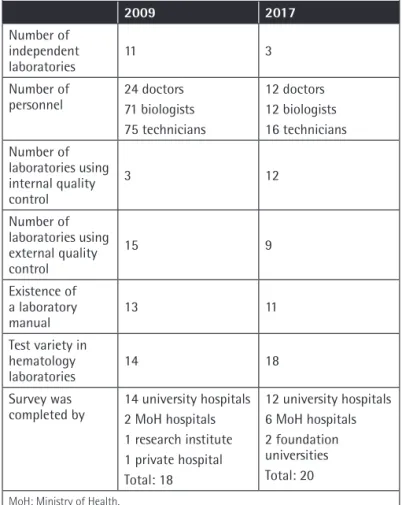215
Turk J Hematol 2018;35:200-216 LETTERS TO THE EDITOR
Results of the Hematology Laboratory Survey: What has Changed
in Eight Years?
Hematoloji Laboratuvarı Anket Sonuçları: Sekiz Yılda Neler Değişti?
İlknur Kozanoğlu1, Türkan Patıroğlu1, Klara Dalva3, Gülderen Yanıkkaya Demirel4, Teoman Soysal5, Muzaffer Demir6
1Başkent University Dr. Turgut Noyan Practice and Research Hospital, Clinic of Hematology, Adana, Turkey 2Erciyes University Faculty of Medicine, Clinic of Hematology, Kayseri, Turkey
3Ankara University Faculty of Medicine, Clinic of Hematology, Ankara, Turkey 4Yeditepe University Faculty of Medicine, Clinic of Hematology, İstanbul, Turkey
5İstanbul University Cerrahpaşa Faculty of Medicine, Department of Hematology, İstanbul, Turkey 6Trakya University Faculty of Medicine, Department of Hematology, Edirne, Turkey
To the Editor,
The Scientific Subcommittee on Laboratory Standards of the Turkish Society of Hematology (TSH) conducted two surveys, in 2009 and 2017, evaluating the tests, devices, and systems used in hematology laboratories (or other laboratories where hematological analyses are performed) in Turkey. The survey was shared online with TSH members as an informational message. Results from the 2017 survey were compared with those obtained in 2009 [1].
The survey was completed by 18 laboratories (14 university hospitals, 2 Ministry of Health education and research hospitals, 1 research institute, 1 private hospital) in 2009 and by 20 laboratories (12 university hospitals, 6 Ministry of Health hospitals, 2 foundation universities) in 2017 (Table 1).
In 2009, 11 (61%) laboratories were independent and 2 (11%) were part of a central laboratory. In 2017, 3 (15%) were independent and 12 (60%) were part of a central laboratory. Regarding employed personnel, respondents in 2009 indicated that 24 medical doctors, 71 biologists, and 75 technicians worked in the laboratories. Respondents in 2017 indicated that 12 medical doctors, 12 biologists, and 16 technicians were employed.
In 2009, only three laboratories conducted internal quality control analyses for all tests. In 2017, internal quality control was conducted for all tests in seven laboratories, flow cytometry in two laboratories, coagulation in two laboratories, and electrophoresis in one laboratory. External quality control programs were utilized in 15 laboratories in 2009 and 9 in 2017. A written hematology laboratory manual was used by 13 (72.2%) and 11 (55%) laboratories in 2009 and 2017, respectively. Performance of molecular studies, flow cytometry analyses, and minimal residual disease tests increased over the 8-year
period. Additionally, 12 (60%) laboratories surveyed in 2017 had automation systems for peripheral blood smears, while none had automation systems in 2009.
In the 2017 survey, eight laboratories responded to the question “What are your expectations from the Laboratory Subcommittee?” Three respondents expressed their views on efforts to develop regulations pertaining to existing legislation,
Table 1. Changes of the hematology laboratories in Turkey between the 2009 and 2017 surveys.
2009 2017
Number of independent
laboratories 11 3
Number of
personnel 24 doctors71 biologists 75 technicians 12 doctors 12 biologists 16 technicians Number of laboratories using internal quality control 3 12 Number of laboratories using external quality control 15 9 Existence of a laboratory manual 13 11 Test variety in hematology laboratories 14 18 Survey was
completed by 14 university hospitals2 MoH hospitals 1 research institute 1 private hospital Total: 18 12 university hospitals 6 MoH hospitals 2 foundation universities Total: 20
216
Turk J Hematol 2018;35:200-216 LETTERS TO THE EDITOR
two indicated a desire for more active training, and three discussed efforts to prepare laboratory guidelines.
Hematology laboratories have not been defined in the Turkish Medical Laboratories Regulation (2010, 2013), which regulates procedures and principles regarding the planning, licensing, opening, regulating, classifying, monitoring, controlling, and terminating of activities of medical laboratories. This has led to the closure of many hematology laboratories and/or their inclusion into a central laboratory system.
Between 2009 and 2017, the number of personnel working in hematology laboratories in Turkey decreased. The hardware and infrastructure are in a position to match the developing technology, but not the standardization [2]. The TSH and the Scientific Subcommittee on Laboratory Standards are closely monitoring the current legislation and efforts are continuing to improve the existing legal situation.
Keywords: Hematology laboratory, Survey, Turkish Society of
Hematology and Laboratory Subcommittee
Anahtar Sözcükler: Hematoloji laboratuvarı, Anket, Türk
Hematoloji Derneği ve Laboratuvar Alt Komitesi
Conflict of Interest: The authors of this paper have no conflicts
of interest, including specific financial interests, relationships, and/or affiliations relevant to the subject matter or materials included.
References
1. Scientific Subcommittee on Laboratory Standards. Survey Results. Ankara, Turkish Society of Hematology, 2017. http://www.thd.org.tr/.
2. Lewis S, Bain B, Bates I. Dacie and Lewis Practical Haematology, 10th Edition. London, Churchill Livingstone, 2006.
Address for Correspondence/Yazışma Adresi: İlknur KOZANOĞLU, M.D.,
Başkent University Dr. Turgut Noyan Practice and Research Hospital, Clinic of Hematology, Adana, Turkey Phone : +90 532 596 56 00
E-mail : ipamuk5@gmail.com ORCID-ID: orcid.org/0000-0002-5268-1210
Received/Geliş tarihi: February 13, 2018 Accepted/Kabul tarihi: April 17, 2018 DOI: 10.4274/tjh.2018.0065
©Copyright 2018 by Turkish Society of Hematology
